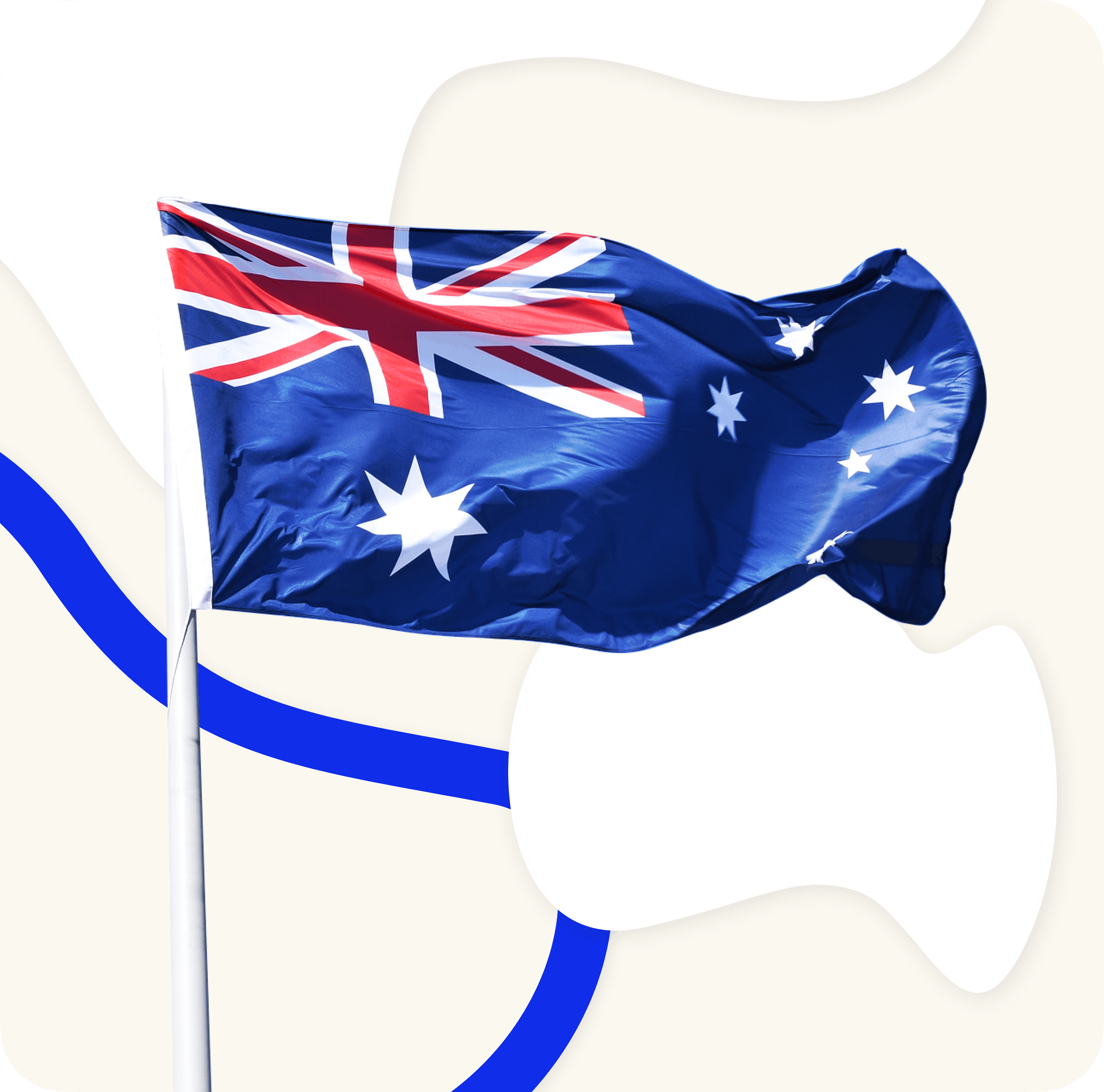Moving to Australia: Relocation Guide
With a robust economy, a high standard of living, and a reputation for beautiful weather, it's no wonder your employees might want to relocate to Australia. But as you know, the immigration process is never straightforward. Beyond the visa application forms and registration appointments, you have to find housing, help family members secure the appropriate visas or permits, and more. It can be quite overwhelming to move employees to Australia.
This Australian relocation guide will help simplify the process. It has everything you need to know, from work visas to the application process and how to find housing for your employees. Australia is a dream location for a work assignment. Here's how to make it a reality – with our guide to relocating employees to Australia.

Which countries are visa/permit exempt for Australia?
Citizens of most countries will need a valid Australian visa to enter the country. The one country exempt from this requirement is New Zealand. New Zealand citizens may enter Australia without a visa. Upon arrival, New Zealand citizens can apply for an Australian Special Category Visa to live or work in Australia indefinitely.
In addition, APEC Business Travel Card holders with the "AUS" code on their cards can enter Australia for business trips lasting up to 90 days. Everyone else will need to apply for an Australian work visa.

What types of work visas are there for Australia?
Australia offers a range of work visas tailored to different employment situations and occupations. Some of these visas are temporary, while others are permanent.

Temporary work visa
The most common temporary work visa is the Australia Temporary Skill Shortage visa, which allows skilled workers to live and work in Australia for two or four years if your employee's home country has an International Trade Obligation (ITO) with Australia. Hong Kong passport holders may stay up to five years. Like similar visas in other countries, the Temporary Skill Shortage visa aims to help Australia address shortages in critical occupations.
Your talent is in good hands with us
10,000+ relocations
4.75 avg. CSAT
4.9 Rating on![]()
How to get a work visa or permit for Australia?
To obtain a work visa or permit for your employee to work in Australia, your first step is to determine the appropriate Australian visa based on the employee's skills, qualifications, and length of residence in the country.
For Australian work visas with a "skilled worker" requirement, your employee may have to submit an Expression of Interest (EOI). You can help the employee submit an EOI through SkillSelect, an online system where Australian immigration officials evaluate potential skilled worker candidates.
If your employee receives an invitation to apply based on their EOI, they can submit their Australia visa application through ImmiAccount, another online service in the Australian immigration system.
Remember, employees will need multiple documents throughout the application process. These include their driver's licence or other state-issued ID, birth certificate, diplomas and other educational certificates, and background checks. Any documents not in English must be translated before submission.
What are the qualification requirements for a work visa or permit in Australia?
Each Australian work visa has its own requirements. In general, however, visa applicants must possess the qualifications, skills, and experience for the type of work they will do in Australia. Proof of a university degree may be required, although a combination of trade qualifications and relevant experience is often sufficient.
Visa applicants may need to demonstrate English language proficiency. The Temporary Skill Shortage visa and other permits may also require your employee to meet specific health and character requirements. This typically involves some health exams and police clearance documents to demonstrate good character.
Is a formal assessment of qualifications required?
A formal assessment of qualifications is often required for Australian skilled work visa applications in Australia. This helps ensure your employee has the qualifications and skills that meet the standards held by native Australians working in similar positions. To validate English language proficiency, these assessments typically involve your employee taking standardised tests, such as the IELTS (International English Language Testing System) or TOEFL (Test of English as a Foreign Language).
In the Australian immigration process, each occupation has its own assessing authority to evaluate applicant qualifications. The assessing authority may request educational transcripts, employment references, or other documentation that supports your employee's expertise. Depending on your employee's occupation, additional standardised tests may be required.
As an employer, you can help your employee prepare for assessments by providing guidance on the required documentation and assessments. You can also establish contact with the assessing authority on behalf of your employee to learn more about applicable assessment requirements.
Which documents do employees need to get ready?
While you can help your employee with much of the Australian immigration process, they are also responsible for preparing many important documents. So, which documents do they need to get ready?
The answer to that question depends on the specific visa they apply for. Australia's Department of Home Affairs (DHA) can give you a checklist of documents your employee will need. However, this list will apply to nearly all applicants, so your employee can start by preparing these documents:
- Valid passport: The passport must be valid for the intended duration of stay in Australia, with some extra time as a buffer.
- Educational documents: Gather certified copies of diplomas, transcripts, training certificates, or any other relevant academic credentials.
- Employment references: Employees should provide reference letters from previous employers and documents verifying their employment history. They should also include a resume or CV listing positions held and duties performed.
- English language proficiency: If required, provide results from standardiszed language tests such as the IELTS or TOEFL.
- Police certificates: Obtain police certificates from all countries where your employee has resided for 12 months or more in the last ten years.
- Health exams: Employees should undergo any necessary health examinations required for the visa subclass and provide doctor-certified records with the results.
Additional documentation may be required. As you learn from the DHA about additional documents your employee must provide, add them to your list.

Can employees move to Australia with family?
Immigration to Australia wouldn't be complete without family. Australia generally welcomes the families of relocating employees. With the Temporary Skill Shortage visa, your employee's family can also live and work in Australia for the entire time the visa is valid.
For permanent visas like the Employer Nomination Scheme (subclass 186) or the Skilled Independent visa, family members can be included in the initial application or apply separately via a Partner or Child visa.
Australia offers excellent public and private schools for relocating children. However, don't forget to research the schools in your employee's intended location and ensure any necessary applications are submitted early.
How to move to Australia with pets
Dogs and cats can immigrate to Australia with their families, but they must meet some health and vaccination requirements. These include microchipping, rabies vaccinations, and blood tests to confirm rabies antibody levels.
Some dog and cat breeds are prohibited due to concerns about their impact on Australia's native wildlife, so be sure your employee checks that their specific dog or cat will be allowed to enter the country.
Other pets, such as birds and rodents, may also make the move to Australia, but they are subject to different quarantine and import conditions. Check the specific requirements for each type of animal early in the relocation planning process.

Residence permits in Australia
While work visas grant temporary residency at a minimum, your employee may eventually want to transition to permanent residency in Australia. There are several paths to permanent residency, and your employee's work visa determines how it works.
The Employer Nomination Scheme (subclass 186) visa is for employee-sponsored skilled workers with a job offer from an Australian employer. If your company has a presence in Australia and your employee qualifies for this subclass, they are immediately granted permanent residency.
The Skilled Nominated Visa (subclass 190) is similar, but it is for employees nominated by an Australian state or territory government. Recipients are also granted permanent residency. For both visas, family members and eligible partners on a Family visa are also granted permanent residency.
Health insurance on a visa in Australia
Work visa holders are required to have adequate health insurance during their stay in Australia. Whether they have a permanent or temporary visa affects how they can get coverage.
If your employee is on a permanent visa or they're transitioning to permanent residency, they are eligible for Medicare, Australia's public healthcare system. However, even with Medicare coverage, some employees may opt for private health insurance. While Australia's public healthcare system is world-class, your employee can access a broader range of services and avoid potential waiting times with private health insurance. Or, if your company provides employees private healthcare coverage, your employee may simply prefer that option.
The type of health insurance required for temporary visa holders depends on your employee's specific visa subclass and their country of origin. Some visas, such as the Temporary Skill Shortage visa, require visa holders and their family members to hold adequate private health insurance for the duration of their stay.

How to prepare for the registration appointment in Australia
Once your employee arrives in Australia, they must register with the relevant immigration authorities. As the employer, you will schedule this registration appointment for your employee well in advance. This gives you time to get ready for a successful registration appointment and a smooth transition into Australian life. Here are five things you and your employee can do ahead of time to prepare:
- Obtain a Tax File Number (TFN): This unique nine-digit number is required for employment in Australia and filing taxes. Employees can apply for a TFN online through the Australian Taxation Office (ATO) website.
- Register with Medicare: If eligible and applicable, employees can register for Medicare once they have their visa and TFN. Online enrollment is quick and easy but can also be done at a Medicare service centre.
- Open an Australian bank account: Opening a bank account early ensures a smooth transition to Australian life and saves some hassle at the registration appointment. Visa holders typically need identification documents such as a passport to open an account.
- Register with local authorities: Register your employee's new Australian address with the relevant government authorities to help ensure a smooth registration appointment.
Enrol children in school: Finding suitable schools for dependent children beforehand saves time and effort at the registration appointment.
Tax & social security needs
Taxes are rarely straightforward in any country, but they can be an exceptionally overwhelming topic for relocating employees. Here's what you and your employee should know about Australia's tax system, and the requirements for working there:
- Progressive tax: Australia has a progressive income tax system, which means those who earn more pay a higher percentage of tax. Employees are taxed on their worldwide income. As an employer, make sure you understand the tax obligations on both Australian and foreign-sourced income earned by your employee.
- Pay As You Go (PAYG): Employers withhold tax from employee salaries and remit it to the Australian Taxation Office (ATO) with the Pay As You Go (PAYG) method. As the employer, you are responsible for providing employees with payment summaries detailing their income and tax withheld.
- Superannuation: Employers are required to contribute a minimum percentage of an employee's salary to a complying superannuation fund. This is Australia's retirement savings program, or what is known as Social Security in some countries.
Medicare levy: Another employment tax for the Australian social safety net is the Medicare levy, which helps fund Australia's public healthcare system. In most cases, employers must withhold and remit the Medicare levy from the employee's salary.


How to find housing in Australia
If you have ever worked on an employee relocation — even in your own country — you know that finding suitable housing can be one of the biggest challenges. You have to consider the city and neighbourhood that places the employee and their family members near work and school. You have to find a house or apartment without seeing the options in person. You may even have to find temporary accommodations until your employee and their family can move into permanent housing.
To help ease the process, connect with Australian real estate agents specialising in rental properties in the general area where your employee will reside. These agents can help you navigate the rental market, schedule virtual tours, and even negotiate lease agreements on your behalf.
Ask the realtor about options for short-term, temporary accommodations. This could be a furnished apartment, a hotel with monthly stays, or a short-term rental. If permanent housing options don't materialise in time, this gives the employee peace of mind that they will have someplace to stay in the meantime.
You can also use online marketplaces to find rental homes and apartments. While this may take more coordination, as you may be dealing with a private landlord instead of a real estate agency, it will help you find more options for your employee. Digging into local classified advertising may also find you a better property for less money.
FAQs about moving to Australia
Now that you've gone through our "How to Move to Australia" guide for employers, let's consider what your employee wants to know. It's natural to have a lot of questions when moving to a new country. Here are answers to some of the most common questions relocating employees have when preparing to migrate to Australia.
Trusted by top HR professionals
Explore other relocation guides

Relocation guide to Spain
Learn essential information on Spanish work visas, settling-in procedures, and more.

Relocation guide to the UK
Get practical advice on UK visa and work permits, as well as settle in the country, and more.

Global relocation guides
Explore our library with all the relocation guides and other useful resources.











